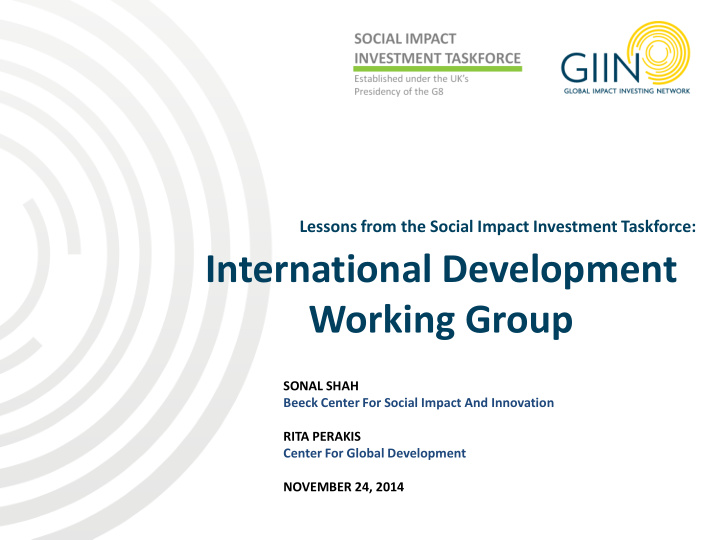



Lessons from the Social Impact Investment Taskforce: International Development Working Group SONAL SHAH Beeck Center For Social Impact And Innovation RITA PERAKIS Center For Global Development NOVEMBER 24, 2014
Introduction to Working Group • Convened to inform Taskforce on the role of impact investment in international development • Collaborative process to advance new ideas for impact investing • How can impact investing drive economic development and social progress in developing countries?
Working Group Members Sonal Shah Georgetown University (CHAIR) Elizabeth Littlefield Overseas Private Investment Corporation Michael Anderson Children's Investment Stewart Paperin Soros Economic Fund Foundation Development Fund Nancy Birdsall Center for Global Development Gerhard Pries Sarona Asset Management Sasha Dichter Acumen Vineet Rai Aavishkaar Toby Eccles Social Finance UK Harold Rosen Grassroots Business Fund Tilman Ehrbeck Consultative Group to Assist Jean-Michel Severino Investisseurs et the Poor Partenaires Roland Gross German Federal Enterprise for Geetha Tharmaratnam The Abraaj Group International Cooperation Ingo Weber GIIN/Leapfrog Rene Karsenti International Capital Market Association David Wilton formerly with the International Julie Katzman Inter-American Development Finance Corporation Bank Mike Kubzansky Omidyar Network
Opportunities for Impact Investing in International Development • Key considerations: – Growing recognition of the role of the private sector in addressing social problems – Need for new capital to developing economies – Advancing market principles in improving the effectiveness of development interventions – Impact investment in conjunction with other sources of public, private and philanthropic capital
The Changing Landscape of Development Finance • Has immense progress, but growth has been uneven and unequal • Aid and philanthropy alone insufficient to solve complex challenges • Landscape for financing is changing radically • Need new finance and investment models for better collaboration and scale
Impact Investing in International Development • Not all investments which have a development impact are “impact investments” • Efforts to differentiate investments that fit definition: targeting social & financial returns and measuring both • Growing number of impact investment funds and vehicles: Acumen Fund, Africa Health Fund, Global Innovation Fund, Development Impact Bonds… • Could be fastest-growing segment of impact investment market
Biggest Challenges Asymmetry of Sharing and Inadequate A need for a more Capital Demand Managing risk metrics and robust ecosystem and Supply transparency • • • Market Governments Market lacks: More capital • asymmetry should explore Common and training to between how to attract understanding build demand for investment to and vocabulary capabilities at investment and higher risk local level • Standardized supply projects • metrics More tools for • • Need to get Sharing of best sharing lessons • Transparency of more social practices and transactions ventures amongst experiences and results to investment- G8/G20 • ensure Greater ready countries knowledge- involvement at • Need for early sharing policy level stage capital
RECOMMENDATION 1: CREATE A NEW IMPACT FINANCE FACILITY • Multi-country effort would target barriers to the impact investing market at a larger scale • “Fund of funds” to stimulate ongoing flow of deals with lower transactions costs • Structure: • Flexible fund for full spectrum of investments • Grant support for technical assistance • Online platform for investors and investees
RECOMMENDATION 2: CREATE A DEVELOPMENT IMPACT BOND OUTCOMES FUND • Accelerate experimentation and learning about DIBs • Help pay for outcomes of successful DIB pilots in a range of sectors • G7 development agencies to contribute to proposed $100 million fund • Outcome funder commitment first step to attract investors • Could link financing with achievement of development goals from post-2015 framework
RECOMMENDATION 3: INCREASE TRANSPARENCY AND IMPROVE METRICS • Support WG efforts to advance impact measurement common guidelines • In international development, DFIs, philanthropic organizations, investors, and local governments should participate and improve their metrics DFIs should: • Identify impact objectives across their portfolios and clarify which are “impact investments” • Publish information on impact investments to facilitate learning, including metrics • Support governments and businesses in developing countries to improve data collection
RECOMMENDATION 4: SUPPORT THE BROADER ENVIRONMENT FOR IMPACT INVESTING • Requires grant capital • Support local governments and intermediaries to build the market • Resources to develop improved metrics • Research on new business models, exit strategies, evaluating new funds and approaches • Mechanisms for sharing knowledge and best practices • Loosen regulatory and legislative constraints on DFIs
Next Steps • Dissemination – Engaging policy community – Finding partners who can help to spread report’s messages – Keeping Working Group members involved
Questions? Have thoughts or feedback? Email the GIIN: Lgustafson@thegiin.org Find the full working group report at www.socialimpactinvestment.org Find the other webinars in this series and further information on impact investing at www.thegiin.org
Additional Slides
• Experiments with social impact bonds are currently underway in the United Kingdom, United States and other developed countries. • Development Impact Bonds are also being explored in India, Uganda, Rwanda and Mozambique
Impact Investing in International Development • Blended finance approaches – Exploring structures to invest investments – Microfinance Initiative for Asia (MiFA) Debt Fund – Development Innovations Ventures • Experimentation by Development agencies – Outcomes based approaches and result-based contracting Social Impact Bonds (SIBs), Pay for Success Contracts (PFS)
Recommend
More recommend